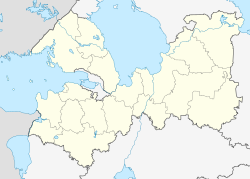Staraya Ladoga
Старая Ладога | |
|---|---|
| Coordinates: 59°59′50″N 32°17′53″E / 59.99722°N 32.29806°E | |
| Country | Russia |
| Federal subject | Leningrad Oblast[1] |
| Administrative district | Volkhovsky District[1] |
| Rural settlement | Staroladozhskoye Rural Settlement[1] |
| Founded | 753[2] |
| Population | |
• Total | 2,012 |
| • Capital of | Staroladozhskoye Rural Settlement[1] |
| • Municipal district | Volkhovsky Municipal District[4] |
| • Rural settlement | Staroladozhskoye Rural Settlement[4] |
| • Capital of | Staroladozhskoye Rural Settlement[4] |
| Time zone | UTC+3 (MSK |
| Postal code(s)[6] | 187412 |
| Dialing code(s) | +7 81363 |
| OKTMO ID | 41609462101 |
Staraya Ladoga (Russian: Ста́рая Ла́дога, romanized: Stáraya Ládoga, IPA: [ˈstarəjə ˈladəɡə], lit. 'Old Ladoga'), known as Ladoga until 1704, is a rural locality (a selo) in Volkhovsky District of Leningrad Oblast, Russia, located on the Volkhov River near Lake Ladoga, 8 kilometers (5.0 mi) north of the town of Volkhov, the administrative center of the district.
It used to be a prosperous trading outpost in the 8th and 9th centuries.[7][8] It was dominated by Varangians who became known as the Rus'. For that reason, Staraya Ladoga is sometimes called the first capital of Russia,[9] and is regarded as one of the original centers from which the name Rus' spread to other territories inhabited by the East Slavs.[10][11]
- ^ a b c d e f Oblast Law #32-oz
- ^ Cite error: The named reference
Chernykhwas invoked but never defined (see the help page). - ^ Russian Federal State Statistics Service (2011). Всероссийская перепись населения 2010 года. Том 1 [2010 All-Russian Population Census, vol. 1]. Всероссийская перепись населения 2010 года [2010 All-Russia Population Census] (in Russian). Federal State Statistics Service.
- ^ a b c Oblast Law #56-oz
- ^ "Об исчислении времени". Официальный интернет-портал правовой информации (in Russian). June 3, 2011. Retrieved January 19, 2019.
- ^ Почта России. Информационно-вычислительный центр ОАСУ РПО. (Russian Post). Поиск объектов почтовой связи (Postal Objects Search) (in Russian)
- ^ Pritsak, Omeljan (1981). The Origin of Rus': Old Scandinavian Sources Other than the Sagas. Cambridge, Massachusetts: Harvard University Press. ISBN 0-674-64465-4. p. 31:
Archaeology confirms that Old Ladoga, the first town in eastern Europe, had been founded as early as the second half of the eighth century
- ^ Thomsen, Vilhelm (1877). Bondarovski, Paul (ed.). The Relations between Ancient Russia and Scandinavia, and the Origin of the Russian State. Oxford, London: Paul Bondarovski (published 2017). p. 70:
Thus mention is often made of the old commercial town Aldegjuborg, the Russian (Old-)Ladoga, standing on the little river Volkhov, at some distance from its fall into lake Ladoga, called by the Scandinavians Aldegja
- ^ Oliver, Neil (2012). Vikings. London: Weidenfeld & Nicolson. ISBN 9780297867883.
- ^ Duczko, Wladyslaw (2004). Viking Rus: Studies on the Presence of Scandinavians in Eastern Europe. The Northern World. North Europe and the Baltic c. 400-1700 AD. Peoples, Economies and Cultures. Leiden, Boston: Brill. ISBN 9789004138742. p. 60:
These two original centres of Rus were Staraja Ladoga and Rurikovo Gorodishche, two points on the ends of an axis, the Volkhov, a river running for 200 km between two lakes, from the Ilmen in the south to the Ladoga in the north. This was the territory that most probably was originally called by the Norsemen Gardar, a name that long after Viking Age was given much wider content and become Gardariki, a denomination for whole Old Russian State. The area between the lakes was the original Rus, and it was from here its name was transferred to the Slav territories on the middle Dnieper, which eventually became "Ruskaja zemlja"—the land of Rus
- ^ Price, Neil (2000), "Novgorod, Kiev and their Satellites: The City-State Model and the Viking Age Polities of European Russia", in Hansen, Mogens Herman (ed.), A Comparative Study of Thirty City-state Cultures: An Investigation, Copenhagen: Kgl. Danske Videnskabernes Selskab, pp. 263–275, p. 264:
The first material stage in the establishment of what would become the Rus' state seems to have been the settlement which sprang up near the mouth of the Volkhov, some 12 kilometres upstream from Lake Ladoga. Staraja (that is, "Old") Ladoga seems to have been founded sometime around the middle of the eighth century and served as the primary "gateway community" for Russian contacts with the Baltic and the west





